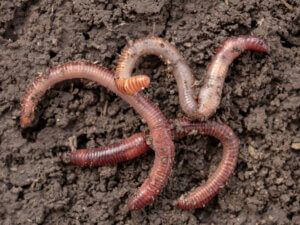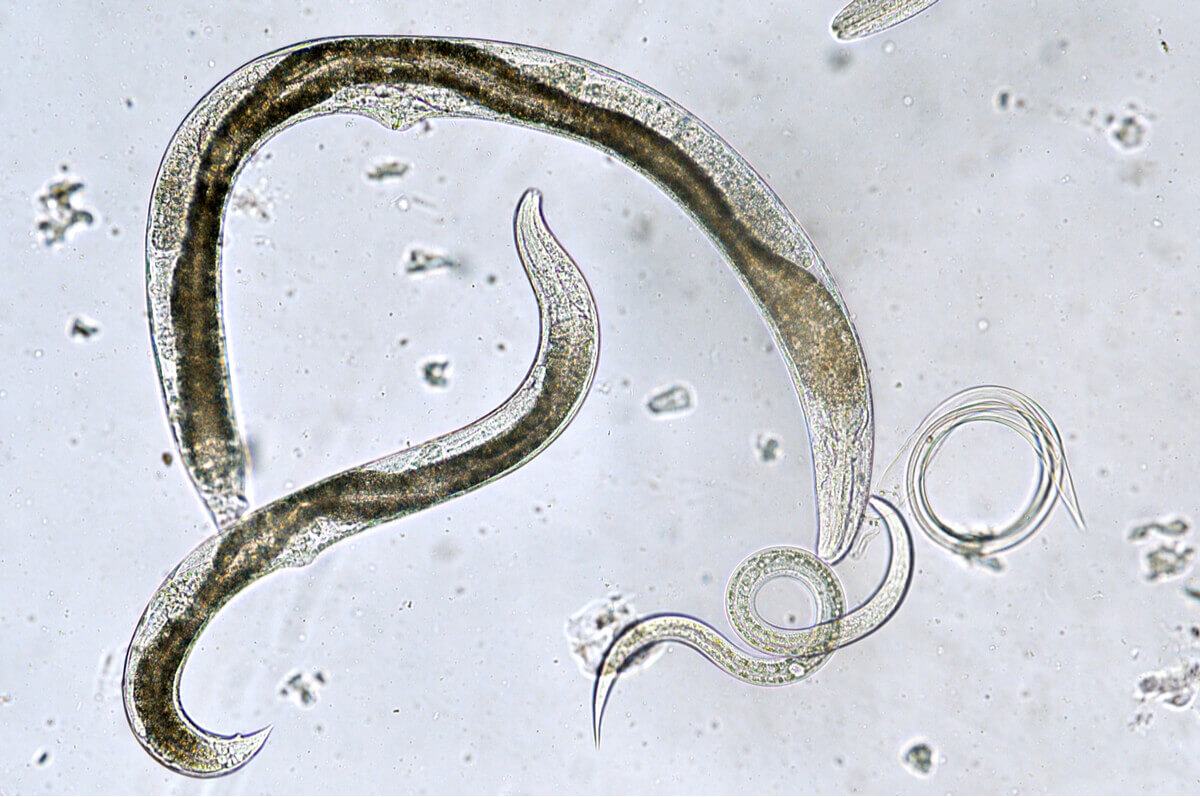Discover How Worms Reproduce

You probably know how certain groups of animals, such as mammals, birds, or reptiles, reproduce, as it somewhat resembles human reproduction. But do you know how worms reproduce? You’ve likely never thought about this issue.
Many soft-bodied and elongated animals are called “worms”. In this interesting article, you’ll discover the types of species that biology considers “worms”, as well as how worms reproduce. Don’t miss it!
What’s a worm?
A worm is any soft-bodied elongated animal that has no limbs. They’re usually anatomically simple animals with underdeveloped respiratory and/or circulatory systems. Thus, many worm species breathe, excrete, and absorb nutrients through the skin.
There are three big groups of worms that experts classify by their body shape. They’re the following:
- Annelids (ringed worms or segmented worms). Some examples are earthworms and leeches. These worms have segments that are divided externally by ring-like constrictions called annuli.
- Platyhelminths or flatworms. Have you heard of the tapeworm? Well, it’s a platyhelminth. Most flatworms are parasites. However, planaria is a free-living flatworm.
- Nematodes or roundworms. They’re cylindrical-shaped worms. Most of them are parasitic, and some of them are microscopic. Well-known examples of this group are roundworms and filaria, the heartworm.
Different worm species can inhabit both land and water. Besides being food for insectivorous animals, they have many other ecosystem functions.
Whether by fertilizing the soil through their droppings (they break down organic matter) or even acting as indicators of water pollution or contamination, worms play many essential roles in nature.

How worms reproduce
Worm reproduction varies by group and species. However, we can boil them down to two main ones. They’re the following:
- Firstly, asexual reproduction. Asexual reproduction only requires one parent. In worms, this usually happens by parthenogenesis, in which a part of the specimen breaks off and regenerates a new one. Most worm species reproduce this way, as it’s a fast way to form new specimens.
- Secondly, sexual reproduction. Most worm species that reproduce sexually are simultaneous hermaphrodites. In other words, they have both male and female sexual organs.
Some species reproduce by copulation, while others are capable of choosing one of the two reproductive systems. In fact, some are even self-fertilizing. In nature, evolution grants living things the tools they need to survive.
Curious examples of how worms reproduce
Although worms can only reproduce in two ways, some species’ reproduction varies so much that it’s almost a mix between asexual and sexual. Curious? Here are some jaw-dropping examples.
Flatworms
Flatworms have the most complex sex organs in the animal kingdom. Most are hermaphrodites and they always resort to internal fertilization, through a complex process.
Their body is divided into segments, each with both male and female reproductive organs. Each of these segments can house eggs resulting from sexual reproduction or by creating a new individual through parthenogenesis, asexually.
Nematodes or roundworms
Nematodes can reproduce sexually through parthenogenesis. In other words, by producing their own eggs and sperm and self-fertilizing. They can also fertilize each other using their copulatory spicules.
How onychophorans reproduce
Experts also call this group of worms velvet worms, due to their velvety texture and somewhat wormlike appearance. There’s a marked sexual dimorphism in this species, as females are bigger and usually have more legs.
The curious thing about these worms is that fertilization occurs by hypodermic impregnation. In other words, the males leave their sperm inside the female’s genital opening. In addition, they’re ovoviviparous, which means that the young emerge from the eggs after the female incubates them inside her.
Osedax
This genus, commonly known as boneworms, can be usually found devouring gray whale skeletons. The curious thing about this genus is that, at first glance, there only seemed to be female specimens. This surprised scientists, since they didn’t seem to reproduce asexually.
However, further analyses with microscopes verified that there were also male specimens. They were microscopic in size and lived within the lumen of the gelatinous tube that surrounds each female. A single female can house hundreds of males inside her tube and lay thousands of eggs throughout the year.

Conclusions on how worms reproduce
As you can see, worm reproduction is fascinating. Although worms aren’t very pleasant to look at, once you begin to discover more and more about them, they become increasingly fascinating.
In short, worms are a clear example that every animal plays an important role in nature. Without these small invertebrates, the ecosystems we enjoy today wouldn’t survive.
You probably know how certain groups of animals, such as mammals, birds, or reptiles, reproduce, as it somewhat resembles human reproduction. But do you know how worms reproduce? You’ve likely never thought about this issue.
Many soft-bodied and elongated animals are called “worms”. In this interesting article, you’ll discover the types of species that biology considers “worms”, as well as how worms reproduce. Don’t miss it!
What’s a worm?
A worm is any soft-bodied elongated animal that has no limbs. They’re usually anatomically simple animals with underdeveloped respiratory and/or circulatory systems. Thus, many worm species breathe, excrete, and absorb nutrients through the skin.
There are three big groups of worms that experts classify by their body shape. They’re the following:
- Annelids (ringed worms or segmented worms). Some examples are earthworms and leeches. These worms have segments that are divided externally by ring-like constrictions called annuli.
- Platyhelminths or flatworms. Have you heard of the tapeworm? Well, it’s a platyhelminth. Most flatworms are parasites. However, planaria is a free-living flatworm.
- Nematodes or roundworms. They’re cylindrical-shaped worms. Most of them are parasitic, and some of them are microscopic. Well-known examples of this group are roundworms and filaria, the heartworm.
Different worm species can inhabit both land and water. Besides being food for insectivorous animals, they have many other ecosystem functions.
Whether by fertilizing the soil through their droppings (they break down organic matter) or even acting as indicators of water pollution or contamination, worms play many essential roles in nature.

How worms reproduce
Worm reproduction varies by group and species. However, we can boil them down to two main ones. They’re the following:
- Firstly, asexual reproduction. Asexual reproduction only requires one parent. In worms, this usually happens by parthenogenesis, in which a part of the specimen breaks off and regenerates a new one. Most worm species reproduce this way, as it’s a fast way to form new specimens.
- Secondly, sexual reproduction. Most worm species that reproduce sexually are simultaneous hermaphrodites. In other words, they have both male and female sexual organs.
Some species reproduce by copulation, while others are capable of choosing one of the two reproductive systems. In fact, some are even self-fertilizing. In nature, evolution grants living things the tools they need to survive.
Curious examples of how worms reproduce
Although worms can only reproduce in two ways, some species’ reproduction varies so much that it’s almost a mix between asexual and sexual. Curious? Here are some jaw-dropping examples.
Flatworms
Flatworms have the most complex sex organs in the animal kingdom. Most are hermaphrodites and they always resort to internal fertilization, through a complex process.
Their body is divided into segments, each with both male and female reproductive organs. Each of these segments can house eggs resulting from sexual reproduction or by creating a new individual through parthenogenesis, asexually.
Nematodes or roundworms
Nematodes can reproduce sexually through parthenogenesis. In other words, by producing their own eggs and sperm and self-fertilizing. They can also fertilize each other using their copulatory spicules.
How onychophorans reproduce
Experts also call this group of worms velvet worms, due to their velvety texture and somewhat wormlike appearance. There’s a marked sexual dimorphism in this species, as females are bigger and usually have more legs.
The curious thing about these worms is that fertilization occurs by hypodermic impregnation. In other words, the males leave their sperm inside the female’s genital opening. In addition, they’re ovoviviparous, which means that the young emerge from the eggs after the female incubates them inside her.
Osedax
This genus, commonly known as boneworms, can be usually found devouring gray whale skeletons. The curious thing about this genus is that, at first glance, there only seemed to be female specimens. This surprised scientists, since they didn’t seem to reproduce asexually.
However, further analyses with microscopes verified that there were also male specimens. They were microscopic in size and lived within the lumen of the gelatinous tube that surrounds each female. A single female can house hundreds of males inside her tube and lay thousands of eggs throughout the year.

Conclusions on how worms reproduce
As you can see, worm reproduction is fascinating. Although worms aren’t very pleasant to look at, once you begin to discover more and more about them, they become increasingly fascinating.
In short, worms are a clear example that every animal plays an important role in nature. Without these small invertebrates, the ecosystems we enjoy today wouldn’t survive.
All cited sources were thoroughly reviewed by our team to ensure their quality, reliability, currency, and validity. The bibliography of this article was considered reliable and of academic or scientific accuracy.
Other Invertebrates (corals, sponges, worms, etc.) – Point Reyes National Seashore (U.S. National Park Service). (2021). National Park Service. https://www.nps.gov/pore/learn/nature/otherinvertebrates.htm
DiCYT, A. (2010). Los gusanos marinos ayudan a detectar la contaminación de los mares. Agencia Iberoamericana para la Difusión de la Ciencia y la Tecnolgía. https://www.dicyt.com/noticias/los-gusanos-marinos-ayudan-a-detectar-la-contaminacion-de-los-mares
Willms, K., Vargas-Parada, L., & Laclette, J. P. (2006). Biología del parásito. Larralde C, De Aluja AS. Cisticercosis. Guía para profesionales de la salud. México, DF: FCE, Secretaría de Salud, Instituto Nacional de Salud Pública, Fundación Mexicana para la Salud, 19-40.
This text is provided for informational purposes only and does not replace consultation with a professional. If in doubt, consult your specialist.








